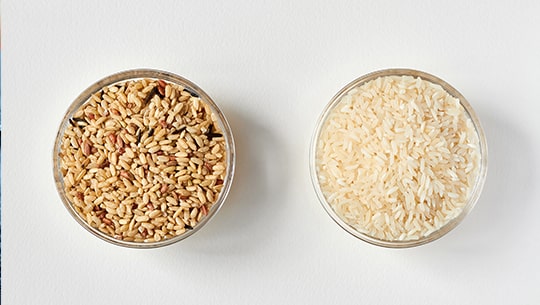There is a common belief that brown rice is healthier than white rice, but this is not always the case. Brown rice and white rice are similar in many ways, but there are some key differences that may affect their nutritional value and impact on health.
One key difference is that brown rice is a whole grain, while white rice is a refined grain. This means that brown rice is minimally processed and contains the bran, germ, and endosperm, while white rice has had the bran and germ removed, leaving only the endosperm. Because of this difference, brown rice tends to be higher in nutrients such as fiber, vitamins, and minerals compared to white rice.
However, it is important to note that the nutritional differences between brown rice and white rice can vary depending on the specific type of rice and how it is prepared. For example, some types of white rice are fortified with nutrients, while others are not. Additionally, the way that rice is cooked (e.g., by boiling, steaming, or frying) can also affect its nutritional content.
Overall, both brown rice and white rice can be part of a healthy diet, but it is important to choose a variety of whole grains in addition to rice and to prepare them in a healthy way (e.g., by boiling or steaming instead of frying).
For years, brown rice has been seen as a healthier option compared to white rice. But is that really the case? Both types of rice have their own health benefits and drawbacks depending on your diet goals. We’ve explored the differences between brown and white rice in order to help you decide which one is best for you. We’ll look at how they are processed, their nutritional content, and how each type can fit into a healthy lifestyle. Ultimately, it’s important to understand that both types of rice offer different advantages so there is no clear winner when it comes to choosing between them.
What’s the difference between brown and white rice?
Many people may not realize it, but there is a significant difference between white and brown rice. Brown rice comes in its natural state, whereas white rice has had the husk, bran, and germ removed through a milling process. As a result of this differentiating factor, brown rice contains more fiber and nutrients than white rice. It also has a mild nutty flavor and chewy texture that many find to be quite pleasant. On the other hand, white rice tends to be softer in both consistency and taste, making it perfect for use in recipes like risottos or paellas. Ultimately, depending on what kind of dish you are planning to make, you may want to opt for one kind of rice over the other due to their various properties.
Benefits of BOTH White and Brown Rice
Both white and brown rice have unique benefits to offer, making them both excellent choices for adding variety to mealtime. To start with, white rice is a great source of carbohydrates which can make it a comforting addition to any meal, while still remaining quite low in calories. On the other hand, brown rice is packed with nutrition; it’s full of beneficial vitamins and minerals including Vitamin B1, manganese and magnesium. Further, brown rice is also rich in dietary fiber which helps support proper digestion. When weighing between the two varieties, consider how your diet could benefit from both varieties as an easy way to stay healthy and enjoy some flavorful meals!
Different Benefits of Brown Rice:
Brown rice has numerous benefits over white rice, making it a clear favorite for many health-minded consumers. Brown rice is much higher in fiber, vitamins and minerals than white rice.
- It is a rich source of essential nutrients such as manganese, iron, vitamin B1 and magnesium. Additionally, brown rice contains phytonutrients which protect the body from disease-causing radicals.
- Studies have also shown that a diet with brown rice is associated with lower levels of LDL cholesterol and triglycerides—both fat markers linked to heart disease.
- Brown rice is also significantly slower to digest than white rice meaning that it can help individuals stay fuller for longer and helps to maintain steady blood sugar levels over time.
Different Benefits of White Rice:
White rice has been highly refined during its production, which helps give it a longer shelf-life than brown rice.
- White rice is often described as having a softer texture and milder flavor than brown rice, making it easier to add to other dishes.
- It also tends to be better tolerated by individuals who have difficulty digesting whole-grains due to gluten sensitivity or digestive problems.
Problems With Eating TOO Much Rice in Your Diet
Eating too much rice can have some negative impacts on one’s overall health. It is a carbohydrate-rich food, and consuming large amounts of rice can lead to an increase in blood sugar levels – something that should be avoided for people with diabetes or other blood sugar-related issues. Eating too many sugars like those found in rice can also cause weight gain due to the extra calories, which can lead to further health complications down the line. Additionally, eating only rice as a main source of nourishment restricts the body from gaining important vitamins and minerals it needs from other sources such as lean proteins, fruits, and vegetables. For these reasons, it is important to eat a balanced diet that includes many different types of sustenance.

